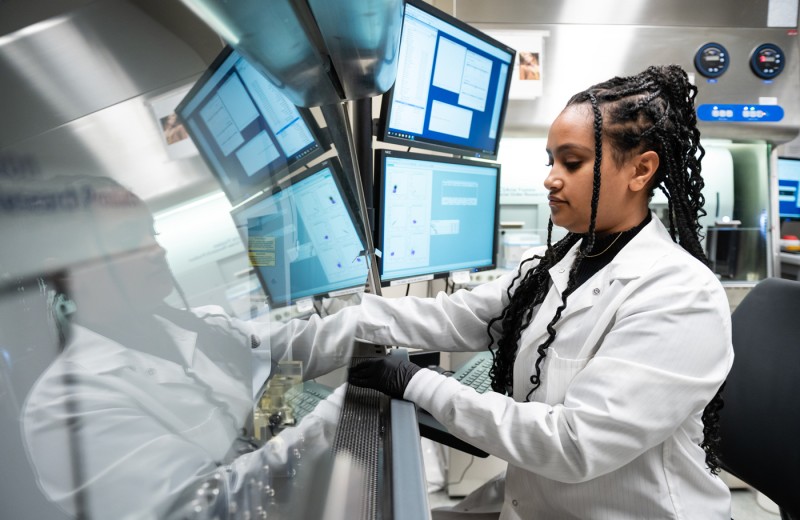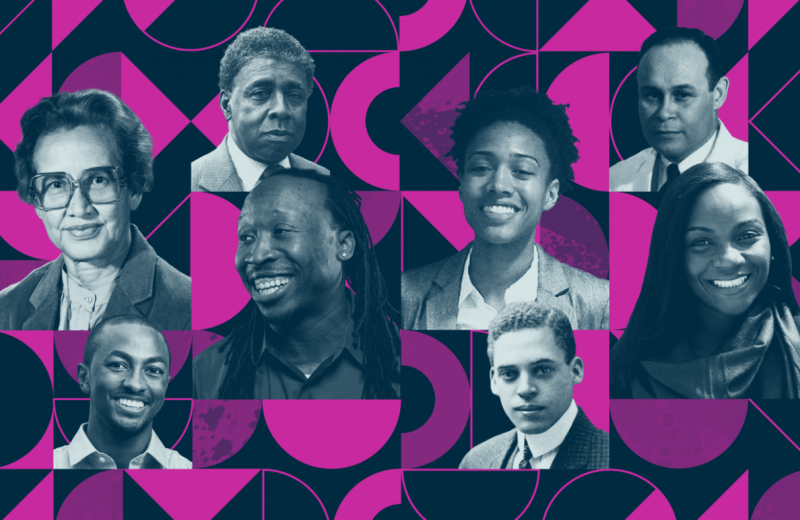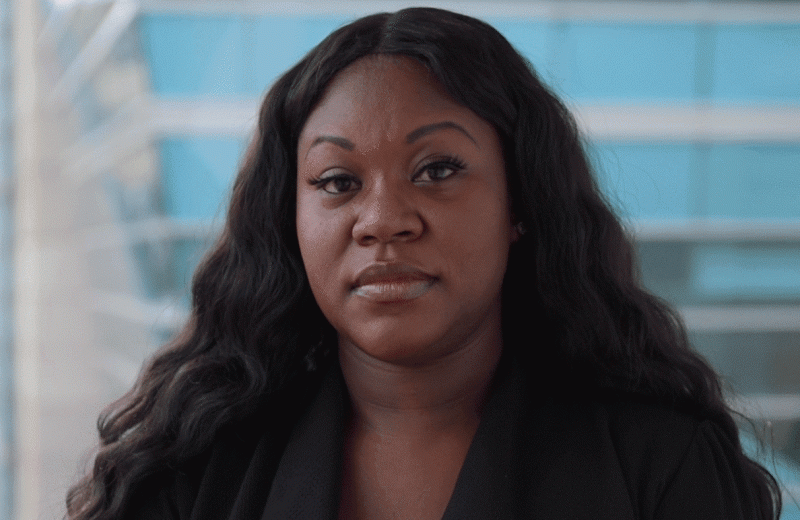Gladstone NOW: The Campaign Join Us on the Journey✕

Stephanie Miller (she/her and they/them), PhD, is a postdoctoral scholar in the lab of Jorge Palop. She was recently named a Berklehammer Scholar. This program supports high-risk, high-reward research projects on dementia with Lewy bodies and related conditions, such as Alzheimer’s disease, Parkinson’s disease, and neuropsychiatric disorders.
What brought you to Gladstone?
I found Gladstone through a pretty fortuitous manner. I was completing my PhD at the University of Maryland and was conducting my research at the National Institutes of Health (NIH), which is just down the road. The office of fellowship sent around a flyer for a program called “Path to Postdoc,” which facilitates interviews for senior graduate students to interview with labs at UC San Francisco and Gladstone in order to apply for postdoc positions. I applied to the program and was delighted to be accepted, and I flew out in spring of 2019 for my interviews. I began my position about a year later.
What do you like most about working at Gladstone?
One of the things that I love most about working at Gladstone was foreshadowed for me by one of my mentors, Sharon Milgram, who’s the director of training at the NIH.
I had asked for her advice as I was preparing for my interview at Gladstone, and the first thing she said was that Gladstone has a top-tier support system for postdoctoral researchers. Gladstone was really setting the standards, so I went in with high expectations. Although I’ve only been at Gladstone for 1 year, my expectations have already been exceeded.
There are two other things that I love about working at Gladstone.
The most important, of course, is science. I really love that at Gladstone, we’re able to let the science and the data guide our research. We have so many incredible resources and support both through the institution and in terms of funding. We receive a wide variety of grants and also philanthropic contributions, which helps provide agency to our scientists. This is so important for excellent science.
On a personal note, I was delighted to walk in the first day and find kombucha available right next to the coffee machine in the lobby. It was just this little perk that I really value and I look forward to having a more normal experience in the building as the pandemic begins to resolve.
Were you interested in science as a child?
As a kid I was definitely interested in science, which began when I was pretty young. One of my favorite hobbies would be to wander around in the woods behind my house and turn over every log and rock in order to find salamanders and other little critters.
My idea of a good time was building little homes for them and watching them. I’d keep them in a little terrarium on my back porch for a couple days and then return them to the wilderness.
So, that was probably an early sign of my interest in science.
Later, as I became a teenager, I really loved science fiction. That was also an important part of my path to science. And then, I began to read science nonfiction. In particular, I read the book Chaos by James Gleik, which is the story of how the science of chaos theory was born in the 70s and who the major players were. I was captivated and at the precocious age of 13, I wanted to grow up to be a fluid dynamicist.
I actually haven’t landed so far from that initial dream. The path that brought me to systems neuroscience at Gladstone has included training in the physics of non-equilibrium dynamics. And that’s what you call chaos these days.
Why did you decide to go to graduate school?
I always knew that I’d like to go to graduate school to get a PhD. My dad is an MD and an emergency room (ER) doctor. He's retired now but I used to occasionally hang out in the ER with him. He worked the night shift, so once in a while I’d get to spend time there. Anytime one of the residents asked me if I wanted to be a doctor when I grew up, I would say no. Specifically, I would say, ‘no, I don’t want to be in school forever.’ Little did I know that the process of pursuing a PhD would involve essentially the same amount of training. But I got to do research in a field that I love, so it’s never really felt like work.
Can you describe a current research project?
In the Palop Lab, we’re studying why brain waves become disorganized in Alzheimer’s disease. We study the cortex, which is the outer layer of the brain responsible for thinking and lots of other higher-order processes. Most of the neurons in the cortex are excitatory cells, but about 20 percent of them are inhibitory cells that function sort of like stoplights. And so what we find is that with Alzheimer’s disease, some of these stoplights get their timing messed up. And we’re trying to find ways to treat or rescue the timing of the stoplight cells so that the entire brain can recover healthy coordination. We’ll know that we’re onto something when our treated disease model mice exhibit behavior that is similar to the healthy mice.
How has the pandemic changed your work?
I arrived at Gladstone in March 2020, which is exactly when the pandemic began to shut everything down. I was on the premises for I think 2 or 3 days, and then we all went totally remote for a while.
There was a significant impact because certain types of training are required before any researcher can work with animals, and we work with mice in the Palop Lab. Those trainings became delayed by many months. So, I had to find a way to hit the ground running with my research without being able to begin any of my own experiments.
Thankfully during my PhD, I had learned how to code. Specifically, I learned how to code on the NIH supercomputer.
When I realized that I was going to have to be working remotely for a while, I threw myself into some new technologies that were just recently released in neuroscience. Specifically, some machine learning techniques that allow us to automatically evaluate the behavior of mice from videos where they walk around or perform different tests. I use the tool DeepLabCut, which had just begun to be used in the Palop Lab. And I assembled a machine learning team. We now meet weekly and it’s really great because it’s totally conducive to remote work. We keep our notes in Google documents so we can edit together collaboratively. At this point, some members of the machine learning team aren’t actually located in San Francisco, or even on the East Coast. But again, because we’re able to work remotely there have been no barriers there. I’m just so proud that we’ve been able to already build a pipeline to bring a new approach to these long-standing and important questions of animal behavior.
Who has influenced your decision to work in science?
I’ve always been drawn to science. My dad actually did most of a master’s in biochemistry before he got into med school. My mother got her associate’s degree in zoology, which was sort of the easiest access that she had to science education at that time. Both of my parents are interested in science, and so they inspired me in that way.
When it came time for me to begin performing scientific studies in classes, I was really encouraged by my professors, especially at Mount Holyoke College, which is where I got my bachelor’s in chemistry.
I didn’t have the easiest time in college. There are certain learning approaches that work best for me that are not necessarily standard and it took me a while to figure this out. But throughout, my science professors were very encouraging. They said, “Stephanie, you’re clearly a bright kid and we’re sure that you can surmount the challenges that you have because we foresee a career in scientific research for you.”
I really appreciated one professor, who told me that I had a great grasp of the big picture for the concepts that we were learning in class. And I also especially appreciated my favorite professor in college who taught me inorganic chemistry and quantum mechanics, and I was also able to take a philosophy course with him on the history of science. I think it’s really important to be able to connect the societal context for our research with the technologies and the outcomes we hope to achieve. Being able to see the full picture is important when aligning our values and achievements as researchers.
How do you hope to get involved with Gladstone’s community groups?
I love organizing at the intersection of communities. I have a long-standing hobby of advocacy in science and marginalized communities. And because I myself am a mixed-race person and a queer person, I stand at the intersection of many communities. I really would like to use my energy to help build and strengthen coalitions between communities who share common goals and can support each other.
When it comes to Gladstone, I have already begun to make connections with Elevated Voices, as well as the Women’s Initiative, and the LGBTQ+ group. I’m just coming up on my 1-year anniversary, and although I don’t know exactly what the most important projects and leverage points are at Gladstone, my general philosophy is to see an increasing harmony between the many roles and positions and inherent stratifications that are present in any workplace, especially in the scientific workforce, where we have the institution, researchers, and support staff. Everybody needs to work together for us to do great work.
Have you developed any fun quarantine hobbies?
During the quarantine, I wish that I could say that I had picked up a hobby of working out every day or meditating every morning, but I am proud to say that I have taken up gardening. I have many tiny plants and hopefully they will grow into big plants.
For me, gardening is actually part of my self-care. If I notice that my plants aren’t thriving, that often means that I’m not thriving, which I may or may not have noticed. So, I really appreciate that my plants are a barometer for how I’m doing.
If you could learn to do anything, what would it be?
If I could learn to do anything, it would be to observe myself better. I really wish I had a readout of my own brain signals at all times. I think that would be very helpful for understanding myself better, and the hobbies that I enjoy. I played the cello when I was young and will occasionally pull it out and pluck at it a bit and play some of the old songs that I used to know. It would just be so cool if I could see my brain waves while I’m playing the cello or doing research, or gardening. I really appreciate metacognition and trying to understand myself better.
What is your hidden talent?
A hidden talent of mine, I suppose, is that I’m actually pretty good at rugby. I was a soccer goalie all throughout my youth. When I got to college, I thought I would take a break from soccer for a little bit. I joined the intramural club rugby team, loved it, and never looked back. Because I had been a goalie for so many years, I quickly picked up a game where you have to catch and pass while being actively tackled. That’s my idea of a good time.
If you could meet any scientist from any point in time, who would it be, and why?
If I could meet any scientifically minded person from any point in time, I would love to meet with Mary Shelley, who is the author of Frankenstein and many other novels. I’d love to talk to her because science fiction has been so important to me growing up and developing an understanding of the natural world.
I’d especially appreciate hearing her opinion on what it was like to make a career as a writer during a period of time where women’s work was often undervalued. So, I’d love to know how she found a way to thrive since she was well-published in her time. I’d also appreciate her thoughts as a politically minded person on how she thinks science is doing today and what she would make of modern scientific ethics.
Anything else you’d like to add?
One thing that I think that researchers can ask themselves is if our research were required to be introduced to middle schoolers or even elementary schoolers, what would we want them to learn. Speaking for myself, I’d like for young children to learn that our brains help us understand our surroundings, especially using the concept of balance. For example, when we make decisions, we balance old information (things we already know) with new information (things we’re learning) at that very moment.
When we want to control our behavior, we have to balance the impulse to act with the need to either delay or perhaps suppress that action. I’d want children to learn that there are parts of our brains that are really good at taking action and parts of our brains that are really good at letting us choose when to delay our actions and wait, if we want to.
And I’d like for kids to learn that in many ways, our brains are like a muscle, and we can practice strengthening these different skills so that we can increase our agency around what we’d like to do when.
Want to Join the Team?
Our people are our most important asset. We offer a wide array of career opportunities both in our administrative offices and in our labs.
Explore CareersProfessional Journeys of Black Gladstonians
Professional Journeys of Black Gladstonians
Get to know our Gladstone community during Black History Month
Profile Elevated Voices DiversityHighlighting Black Scientists from Past to Present
Highlighting Black Scientists from Past to Present
Featuring Black scientists throughout history
Elevated Voices DiversityMeet Gladstone: Nicole Velasquez
Meet Gladstone: Nicole Velasquez
Nicole Velasquez shares why she loves working at Gladstone, the importance of Black History Month, and how she spends her time outside of work
Elevated Voices Profile Diversity



